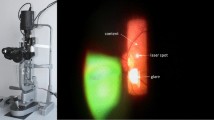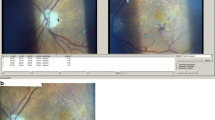Abstract
Purpose
The slit lamp is an essential instrument for eye care. It is used in navigated laser treatment with retina mosaicing to assist diagnosis. Specifics of the imaging setup introduce bothersome illumination artifacts. They not only degrade the quality of the mosaic but may also affect the diagnosis. Existing solutions in SLIM manage to deal with strong glares which corrupt the retinal content entirely while leaving aside the correction of semitransparent specular highlights and lens flare. This introduces ghosting and information loss.
Methods
We propose an effective technique to detect and correct light reflections of different degrees in SLIM. We rely on the specular-free image concept to obtain glare-free image and use it coupled with a contextually driven probability map to segment the visible part of the retina in every frame before image mosaicing. We then perform the image blending on a subset of all spatially aligned frames. We detect the lens flare and label each pixel as ‘flare’ or ‘non flare’ using a probability map. We then invoke an adequate blending method. We also introduce a new quantitative measure for global photometric quality.
Results
We tested on a set of video sequences obtained from slit lamp examination sessions of 11 different patients presenting healthy and unhealthy retinas. The segmentation of glare and visible retina was evaluated and compared to state-of-the-art methods. The correction of lens flare and semitransparent highlight with content-aware blending was applied and its performance was evaluated qualitatively and quantitatively.
Conclusion
The experiments demonstrated that integrating the proposed method to the mosaicing framework significantly improves the global photometric quality of the mosaics and outperforms existing works in SLIM.






Similar content being viewed by others
References
Allan M, Ourselin S, Thompson S, Hawkes DJ, Kelly J, Stoyanov D (2013) Toward detection and localization of instruments in minimally invasive surgery. IEEE Trans Biomed Eng 60(4):1050–1058
Asmuth J, Madjarov B, Sajda P, Berger JW (2001) Mosaicking and enhancement of slit lamp biomicroscopic fundus images. Br J Ophthalmol 85(5):563–565
Boykov Y, Jolly MP (2000) Interactive organ segmentation using graph cuts. In: International conference on medical image computing and computer-assisted intervention, pp 276–286. Springer
Chhatkuli A, Bartoli A, Malti A, Collins T. (2014) Live image parsing in uterine laparoscopy. In: 2014 IEEE 11th international symposium on biomedical imaging (ISBI), pp 1263–1266. IEEE
Kim H, Jin H, Hadap S, Kweon I. (2013) Specular reflection separation using dark channel prior. In: Proceedings of the IEEE conference on computer vision and pattern recognition, pp 1460–1467
Lange H (2005) Automatic glare removal in reflectance imagery of the uterine cervix. In: Medical Imaging, pp 2183–2192. International Society for Optics and Photonics
Nussberger A, Grabner H, Van Gool L (2015) Robust aerial object tracking in images with lens flare. In: 2015 IEEE international conference on robotics and automation, pp 6380–6387. IEEE
Prokopetc K, Bartoli A (2016) A comparative study of transformation models for the sequential mosaicing of long retinal sequences of slit-lamp images obtained in a closed-loop motion. Int J Comput Assis Radiol Surg 1–10
Prokopetc K, Bartoli A (2016) Reducing drift in mosaicing slit-lamp retinal images. In: The IEEE conference on computer vision and pattern recognition (CVPR) workshops, pp 93–100. IEEE
Prokopetc K, Collins T, Bartoli A (2015) Automatic detection of the uterus and fallopian tube junctions in laparoscopic images. In: International conference on information processing in medical imaging, pp 552–563. Springer
Reinhard E, Stark M, Shirley P, Ferwerda J (2002) Photographic tone reproduction for digital images. ACM Trans Gr 21(3):267–276
Richa R, Linhares R, Comunello E, von Wangenheim A, Schnitzler JY, Wassmer B, Guillemot C, Thuret G, Gain P, Hager G et al (2014) Fundus image mosaicking for information augmentation in computer-assisted slit-lamp imaging. IEEE Trans Med Imaging 33(6):1304–1312
Saint-Pierre CA, Boisvert J, Grimard G, Cheriet F (2011) Detection and correction of specular reflections for automatic surgical tool segmentation in thoracoscopic images. Mach Vision Appl 22(1):171–180
Shen HL, Zhang HG, Shao SJ, Xin JH (2008) Chromaticity-based separation of reflection components in a single image. Pattern Recognit 41(8):2461–2469
Sun C, Liu S, Yang T, Zeng B, Wang Z, Liu G (2016) Automatic reflection removal using gradient intensity and motion cues. In: Proceedings of the ACM on multimedia conference, pp 466–470. ACM
Tan RT, Ikeuchi K (2005) Separating reflection components of textured surfaces using a single image. IEEE Trans Pattern Anal Mach Intell 27(2):178–193
Xu C, Wang X, Wang H, Zhang Y (2015) Accurate image specular highlight removal based on light field imaging. In: Visual Communications and Image Processing, pp. 1–4. IEEE
Yang Q, Wang S, Ahuja N (2010) Real-time specular highlight removal using bilateral filtering. In: European conference on computer vision, pp 87–100. Springer
Yang Q, Wang S, Ahuja N, Yang R (2011) A uniform framework for estimating illumination chromaticity, correspondence, and specular reflection. IEEE Trans Image Process 20(1):53–63
Zanet S, Rudolph T, Richa R, Tappeiner C, Sznitman R (2016) Retinal slit lamp video mosaicking. Int J Comput Assist Radiol Surg 1–7
Author information
Authors and Affiliations
Corresponding author
Ethics declarations
Conflict of interest
The authors declare that they have no conflict of interest.
Ethical approval
All procedures performed in studies involving human participants were in accordance with the ethical standards of the institutional andor national research committee and with the 1964 Helsinki Declaration and its later amendments or comparable ethical standards.
Informed consent
Informed consent was obtained from all individual participants included in the study.
Rights and permissions
About this article
Cite this article
Prokopetc, K., Bartoli, A. SLIM (slit lamp image mosaicing): handling reflection artifacts. Int J CARS 12, 911–920 (2017). https://doi.org/10.1007/s11548-017-1555-z
Received:
Accepted:
Published:
Issue Date:
DOI: https://doi.org/10.1007/s11548-017-1555-z




